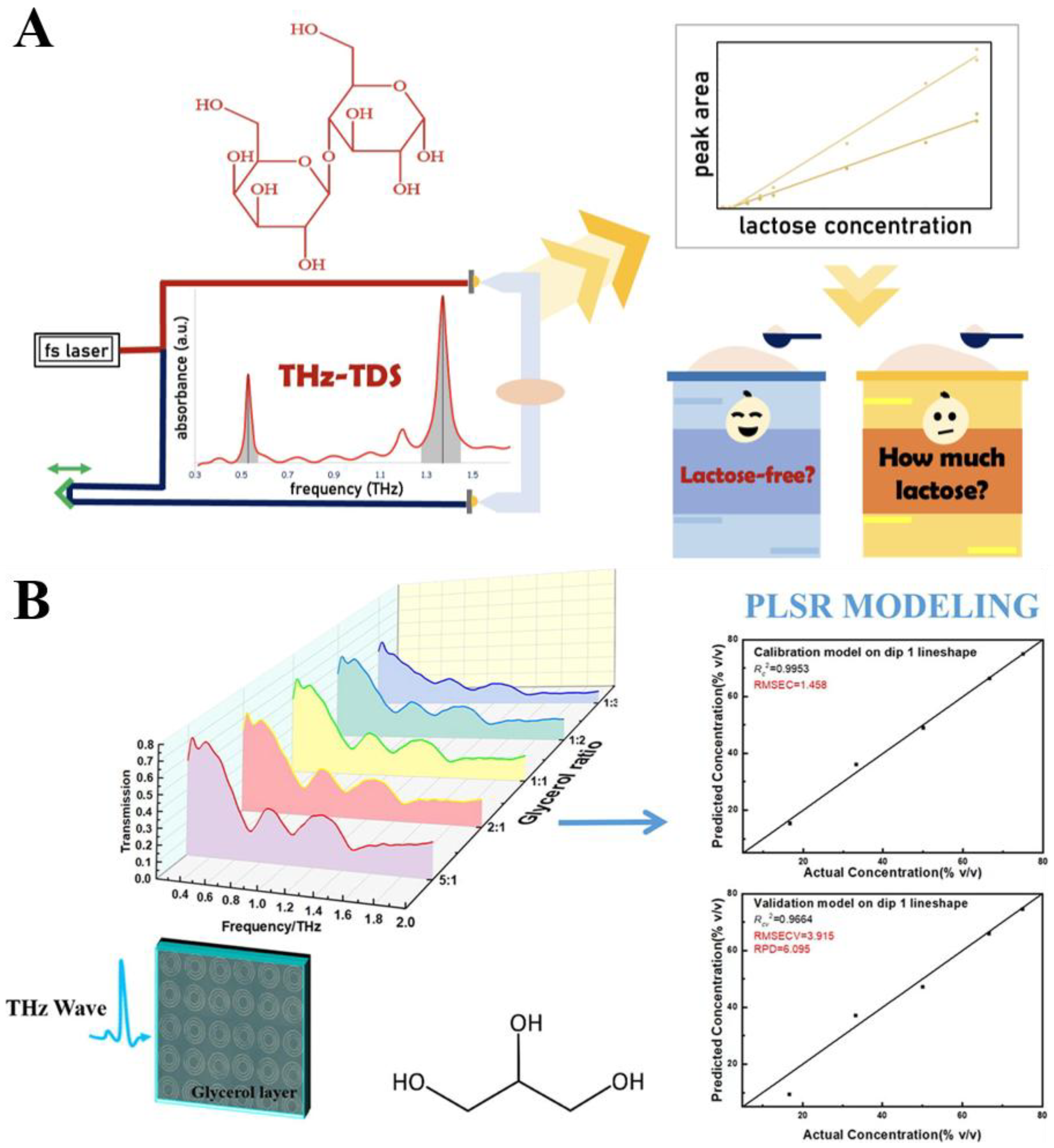Recent Developments and Applications of Terahertz Spectroscopy in Food Analysis
Abstract
1. Introduction
2. Principles of Terahertz Spectroscopy
2.1. Terahertz Time Domain Spectroscopy (THz-TDS) System
2.2. Terahertz Metamaterial
3. Application of Terahertz Spectroscopy in Food Analysis
3.1. Harmful Substance Detection
3.1.1. Pesticide Residues

3.1.2. Antibiotics
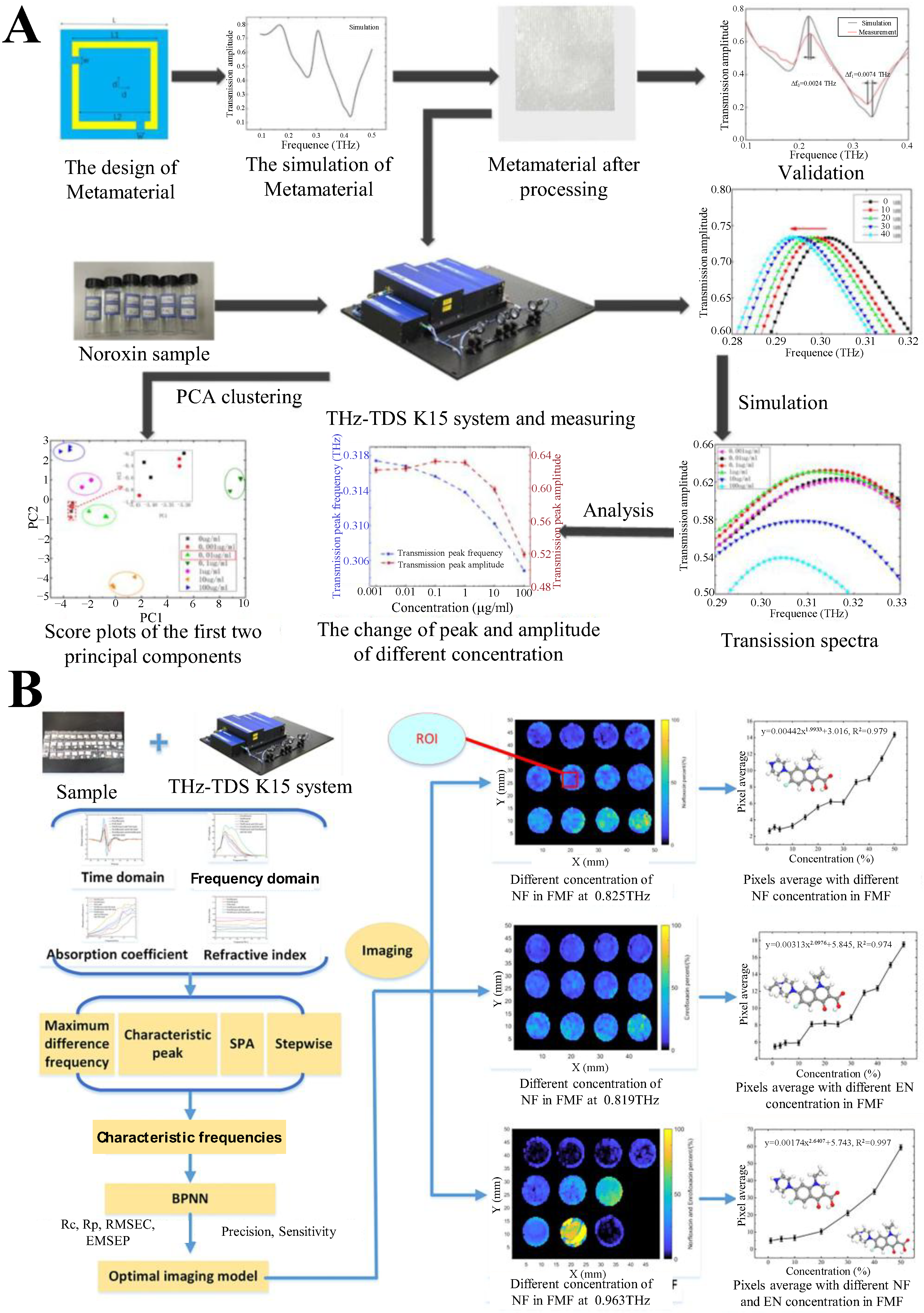
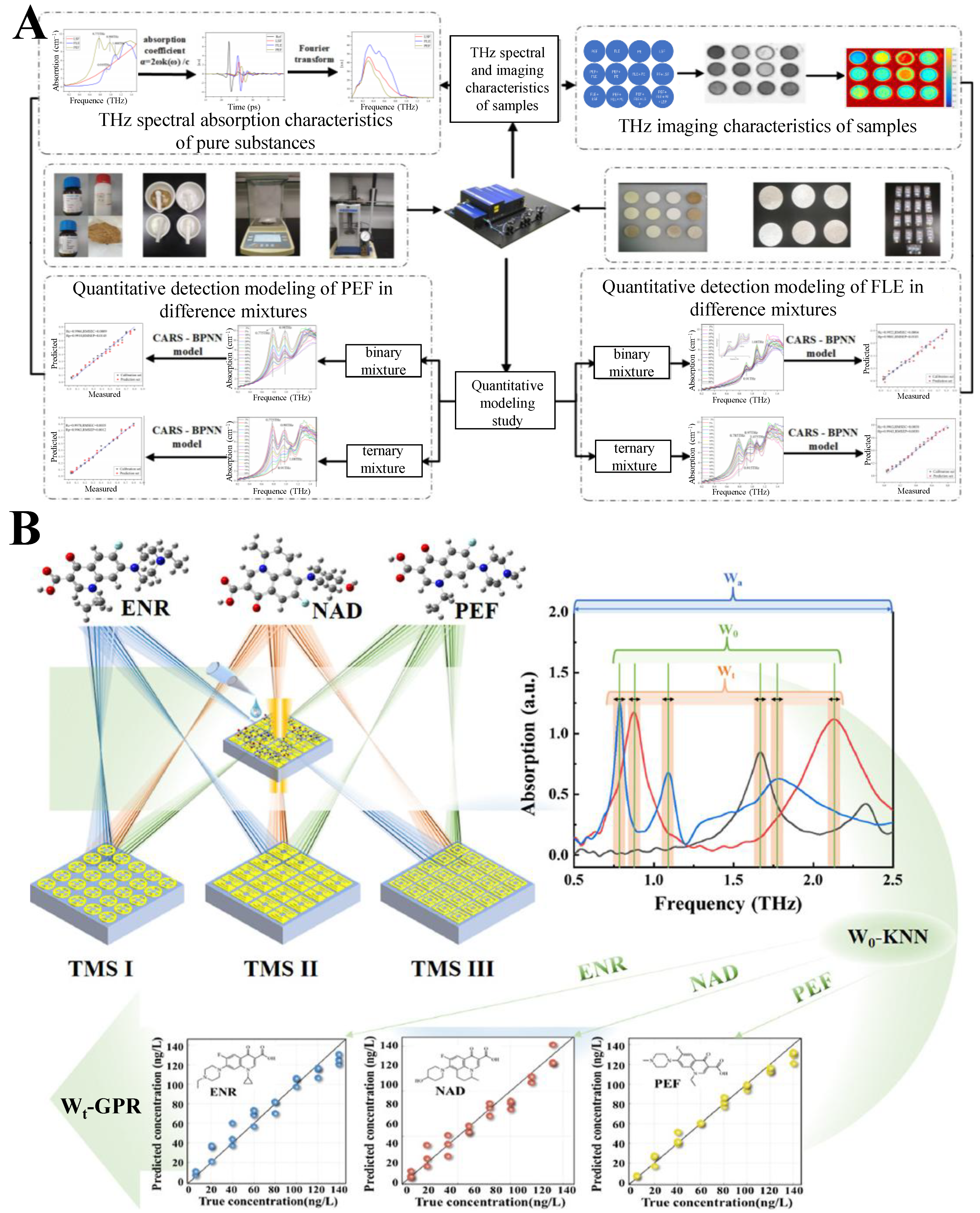
3.1.3. Additives
3.1.4. Pathogenic Bacteria and Toxins
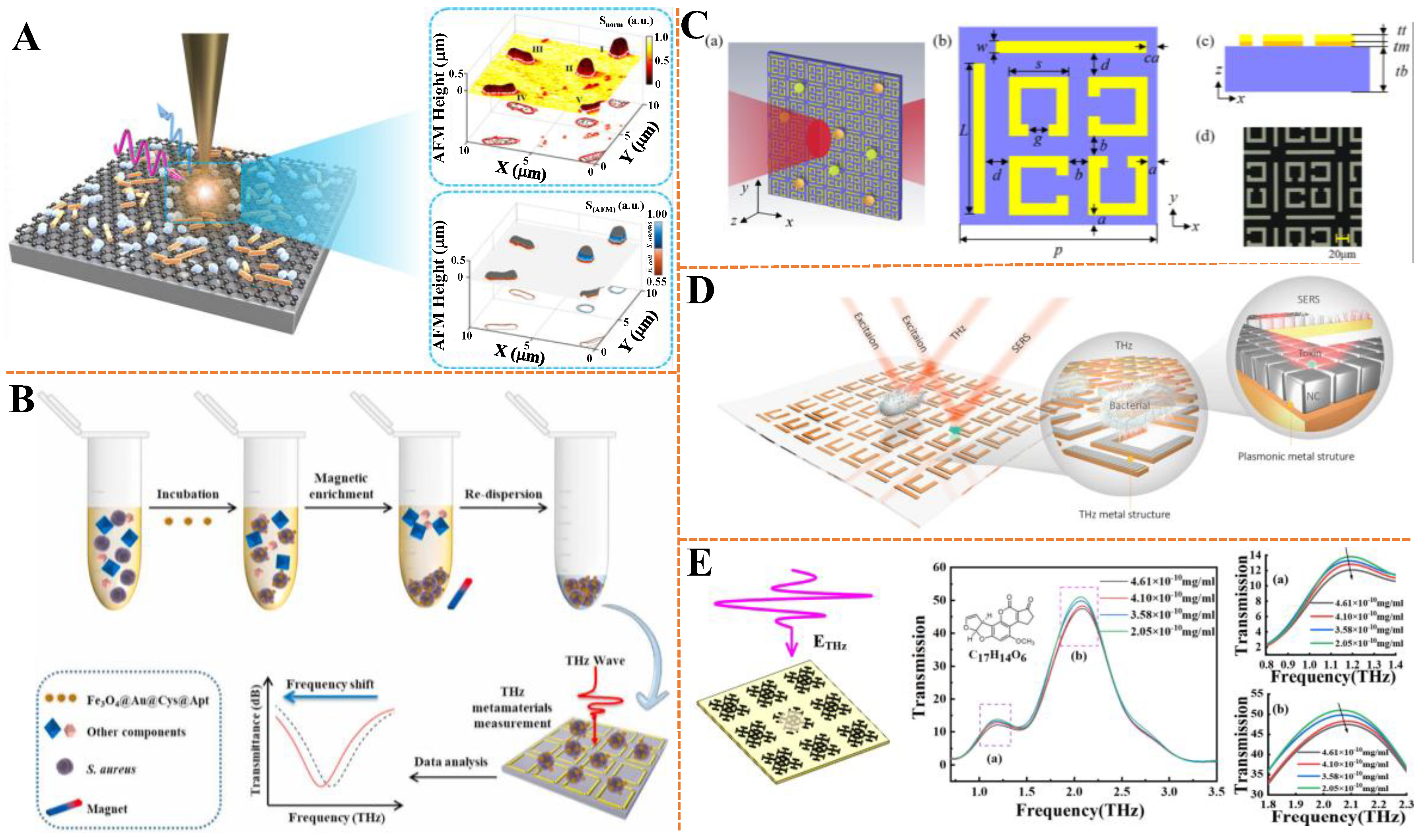
3.2. Component Analysis
3.3. Quality Assessment
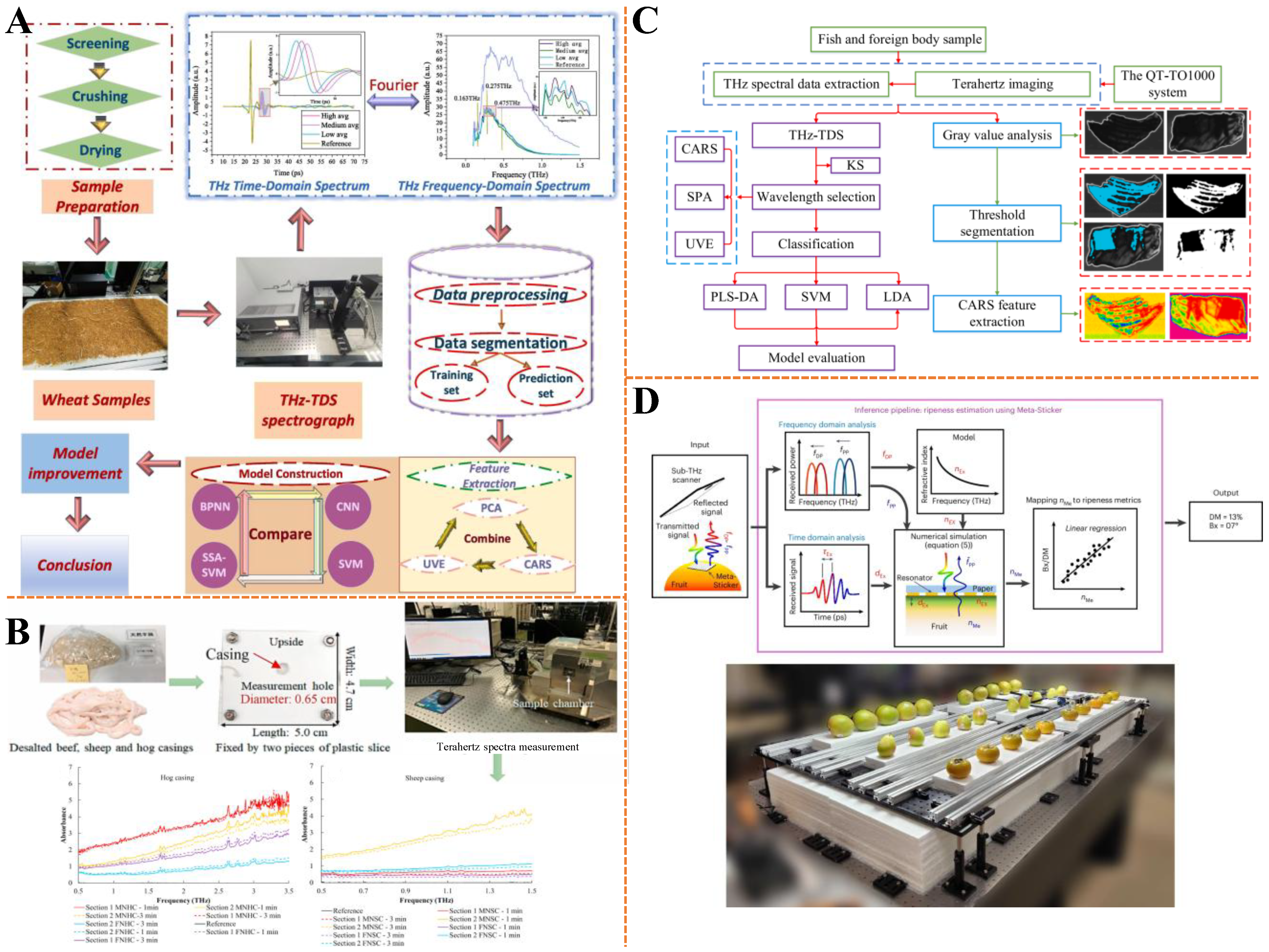
3.4. Adulteration Identification
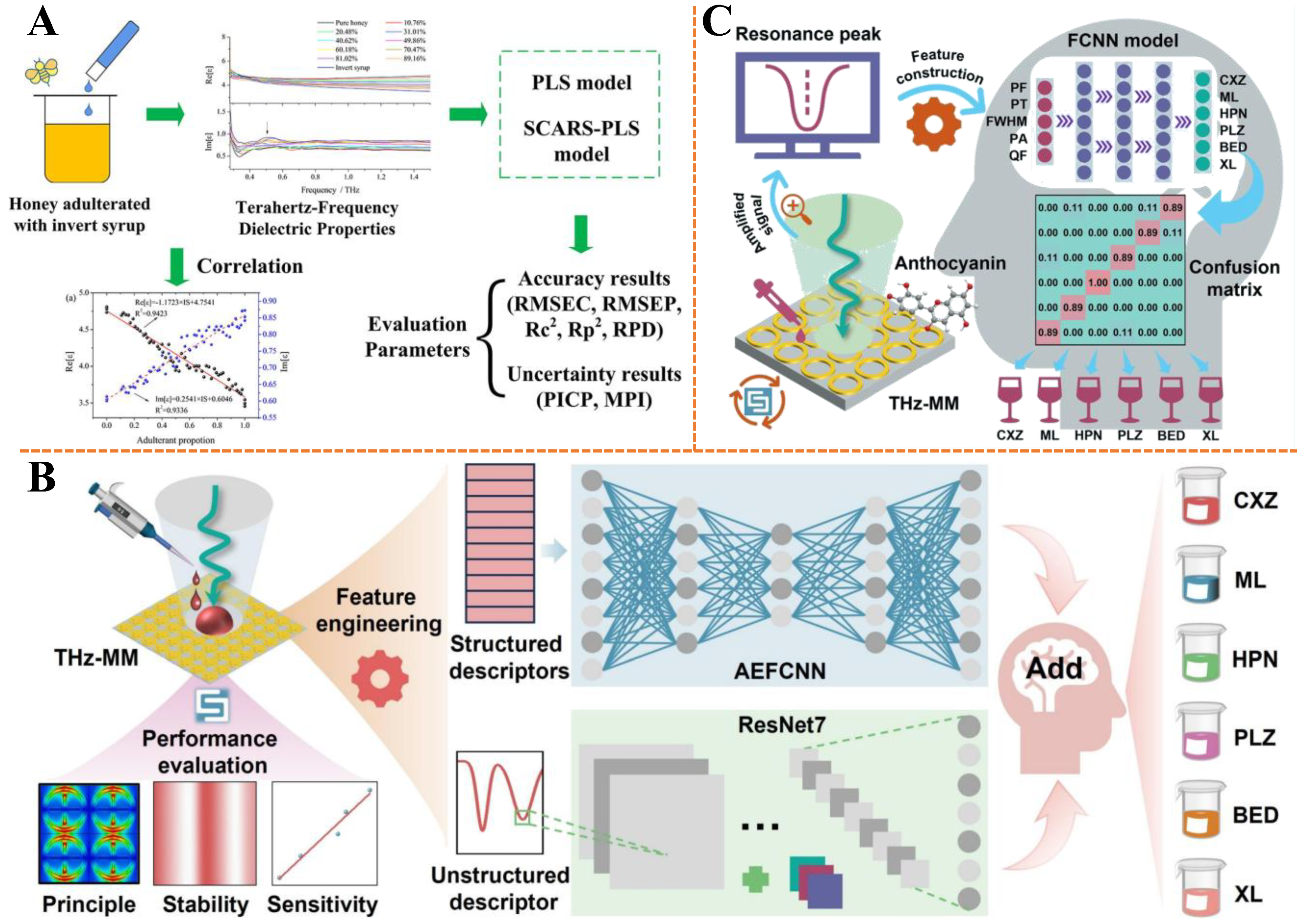
4. Summary and Prospects
Author Contributions
Funding
Data Availability Statement
Conflicts of Interest
Abbreviations
| THz-TDS | Terahertz frequency-domain spectroscopy |
| ATR | Attenuated total reflection |
| 2,4-D | 2,4-dichlorophenoxyacetic acid |
| DFT | Density functional theory |
| LOD | Limit of detection |
| USM | Umbrella-shaped metamaterial |
| RMSE | Root mean square error |
| COF | Covalent organic frameworks |
| PI | Polyimide |
| PCA | Principal component analysis |
| FQs | Fluoroquinolones |
| FMFs | Fish meal feeds |
| SPA | Successive projections algorithm |
| NF | Norfloxacin |
| ENR | Enrofloxacin |
| BPNN | Backpropagation neural network |
| PEF | Pefloxacin |
| FLE | Fleroxacin |
| CARS | Competitive adaptive reweighted sampling |
| TC4 | Three-concentric C4-symmetrical split-ring |
| MRR-CSF | Multiple resonance response competition and selection fusion |
| KNN | K-Nearest Neighbor |
| CAP | Chloramphenicol |
| AuF-MM | Gold film metamaterial |
| CAP-BSA | CAP–bovine serum albumin |
| AuNPs-mAb | Colloidal gold-labeled CAP monoclonal antibodies |
| CSs | Citrate salts |
| ADA | Azodicarbonamide |
| SG | Savitzky–Golay |
| LSTM | Long short-term memory |
| LS-SVM | Least squares support vector machine |
| S. aureus | Staphylococcus aureus |
| E. coli | Escherichia coli |
| STDN | Single-bacterium terahertz dielectric nanoimaging |
| S. epidermidis | Staphylococcus epidermidis |
| AgNCs | Ag nanocubes |
| AFB2 | Aflatoxin B2 |
| MC | Moisture content |
| PFBD | Pulsed fluidized bed dryer |
| CNNs | Convolutional neural networks |
| PLSR | Partial least squares regression |
| SVR | Support vector regression |
| HSI | Hyperspectral imaging |
| NIR-HSI | Near-infrared hyperspectral imaging |
| GPR | Gaussian process regression |
| SVM | Support vector machine |
| FSS | Frequency-selective surface |
| FT-THz | Fourier-transform terahertz |
| HMT | Heat-moisture treatment |
| XRD | X-ray diffraction |
| SSA-SVM | Sparrow algorithm optimised support vector machines |
| UVE | Uninformative variable elimination |
| Meta-Sticker | Metamaterial sticker |
| SCARS | Stability competitive adaptive reweighted sampling |
| RF | Random forest |
| MCUVE | Monte Carlo uninformative variable elimination |
| PLS | Partial least squares |
| FCNN | Fully connected neural network |
References
- Du, Z.; Hu, Y.; Ali Buttar, N.; Mahmood, A. X-ray computed tomography for quality inspection of agricultural products: A review. Food Sci. Nutr. 2019, 7, 3146–3160. [Google Scholar] [CrossRef]
- Mao, Y.; Sun, M.; Hong, X.; Chakraborty, S.; Duan, J.; Li, M.; Du, D. Semi-quantitative and quantitative detection of ochratoxin A in agricultural by-products using a self-assembling immunochromatographic strip. J. Sci. Food Agr. 2021, 101, 1659–1665. [Google Scholar] [CrossRef]
- Fakhlaei, R.; Selamat, J.; Khatib, A.; Razis, A.F.A.; Sukor, R.; Ahmad, S.; Babadi, A.A. The Toxic Impact of Honey Adulteration: A Review. Foods 2020, 9, 1538. [Google Scholar] [CrossRef] [PubMed]
- Yao-Say Solomon Adade, S.; Lin, H.; Jiang, H.; Haruna, S.A.; Osei Barimah, A.; Zareef, M.; Akomeah Agyekum, A.; Adwoa Nkuma Johnson, N.; Mehedi Hassan, M.; Li, H.; et al. Fraud detection in crude palm oil using SERS combined with chemometrics. Food Chem. 2022, 388, 132973. [Google Scholar] [CrossRef]
- Zhu, J.; Agyekum, A.A.; Kutsanedzie, F.Y.H.; Li, H.; Chen, Q.; Ouyang, Q.; Jiang, H. Qualitative and quantitative analysis of chlorpyrifos residues in tea by surface-enhanced Raman spectroscopy (SERS) combined with chemometric models. LWT 2018, 97, 760–769. [Google Scholar] [CrossRef]
- Hong, Y.-Q.; Guo, X.; Chen, G.-H.; Zhou, J.-W.; Zou, X.-M.; Liao, X.; Hou, T. Determination of five macrolide antibiotic residues in milk by micellar electrokinetic capillary chromatography with field amplified sample stacking. J. Food Saf. 2018, 38, e12382. [Google Scholar] [CrossRef]
- Shao, Y.-X.; Chen, G.-H.; Fang, R.; Zhang, L.; Yi, L.-X.; Meng, H.-L. Analysis of Six β-Lactam Residues in Milk and Egg by Micellar Electrokinetic Chromatography with Large-Volume Sample Stacking and Polarity Switching. J. Agr. Food Chem. 2016, 64, 3456–3461. [Google Scholar] [CrossRef]
- Liu, J.; Chen, N.; Yang, J.; Yang, B.; Ouyang, Z.; Wu, C.; Yuan, Y.; Wang, W.; Chen, M. An integrated approach combining HPLC, GC/MS, NIRS, and chemometrics for the geographical discrimination and commercial categorization of saffron. Food Chem. 2018, 253, 284–292. [Google Scholar] [CrossRef]
- Ma, L.; Han, E.; Yin, L.; Xu, Q.; Zou, C.; Bai, J.; Wu, W.; Cai, J. Simultaneous detection of mixed pesticide residues based on portable Raman spectrometer and Au@Ag nanoparticles SERS substrate. Food Control 2023, 153, 109951. [Google Scholar] [CrossRef]
- Hassan, M.M.; Yi, X.; Zareef, M.; Li, H.; Chen, Q. Recent advancements of optical, electrochemical, and photoelectrochemical transducer-based microfluidic devices for pesticide and mycotoxins in food and water. Trends Food Sci. Tech. 2023, 142, 104230. [Google Scholar] [CrossRef]
- Li, Y.; Pan, T.; Li, H.; Chen, S. Non-invasive quality analysis of thawed tuna using near infrared spectroscopy with baseline correction. J. Food Process Eng. 2020, 43, e13445. [Google Scholar] [CrossRef]
- Tahir, H.E.; Xiaobo, Z.; Jianbo, X.; Mahunu, G.K.; Jiyong, S.; Xu, J.-L.; Sun, D.-W. Recent Progress in Rapid Analyses of Vitamins, Phenolic, and Volatile Compounds in Foods Using Vibrational Spectroscopy Combined with Chemometrics: A Review. Food Anal. Method. 2019, 12, 2361–2382. [Google Scholar] [CrossRef]
- Saleem, A.; Imtiaz, A.; Yaqoob, S.; Awais, M.; Awan, K.A.; Naveed, H.; Khalifa, I.; Al-Asmari, F.; Qian, J.-Y. Integration of Fluorescence Spectroscopy Along with Mathematical Modeling for Rapid Prediction of Adulteration in Cooked Minced Beef Meat. J. Food Process Eng. 2024, 47, e70003. [Google Scholar] [CrossRef]
- Cong, M.; Zhang, Z.; Song, W.; Qiu, J. Food safety application of Terahertz spectroscopy based on metamaterials: A review. J. Food Compos. Anal. 2025, 139, 107034. [Google Scholar] [CrossRef]
- Zhang, X.; Wang, P.; Mao, H.; Gao, H.; Li, Q. Detection of the nutritional status of phosphorus in lettuce using thz time-domain spectroscopy. Eng. Agrícola 2021, 41, 599–608. [Google Scholar] [CrossRef]
- Tong, Y.; Ding, L.; Han, K.; Zou, X.; Wang, S.; Wen, Z.; Ye, Y.; Ren, X. Detection of carbendazim in oranges with metal grating integrated microfluidic sensor in terahertz. Food Addit. Contam. A 2022, 39, 1555–1564. [Google Scholar] [CrossRef]
- Zhang, X.; Wang, Y.; Zhou, Z.; Zhang, Y.; Wang, X. Detection Method for Tomato Leaf Mildew Based on Hyperspectral Fusion Terahertz Technology. Foods 2023, 12, 535. [Google Scholar] [CrossRef]
- van Exter, M.; Fattinger, C.; Grischkowsky, D. Terahertz time-domain spectroscopy of water vapor. Opt. Lett. 1989, 14, 1128–1130. [Google Scholar] [CrossRef]
- Ralph, S.E.; Grischkowsky, D. Terahertz Beams: Generation and Spectroscopy. MRS Online P. Libr. 1992, 261, 89–100. [Google Scholar] [CrossRef]
- Shin, H.J.; Choi, S.-W.; Ok, G. Qualitative identification of food materials by complex refractive index mapping in the terahertz range. Food Chem. 2018, 245, 282–288. [Google Scholar] [CrossRef]
- Yang, L.-H.; Maeng, I.; Lee, S.; Kim, K.; Ji, Y.B.; Bark, H.S.; Shin, H.J.; Oh, S.J. Qualitative analysis of edible oil mixture for omega-3 content using terahertz time-domain spectroscopy. npj Sci. Food 2025, 9, 140. [Google Scholar] [CrossRef] [PubMed]
- Nie, P.; Qu, F.; Lin, L.; Dong, T.; He, Y.; Shao, Y.; Zhang, Y. Detection of Water Content in Rapeseed Leaves Using Terahertz Spectroscopy. Sensors 2017, 17, 2830. [Google Scholar] [CrossRef]
- Akiyama, K.; Horita, K.; Sakamoto, T.; Satozono, H.; Takahashi, H.; Goda, Y. Monitoring the Progress of Lactic Acid Fermentation in Yogurt Manufacturing Using Terahertz Time-Domain–Attenuated Total-Reflection Spectroscopy. J. Infrared Millim. Te. 2019, 40, 1160–1167. [Google Scholar] [CrossRef]
- Nguyen, D.T.; Pissard, A.; Pierna, J.A.F.; Rogez, H.; Souza, J.; Dortu, F.; Goel, S.; Hernandez, Y.; Baeten, V. A method for non-destructive determination of cocoa bean fermentation levels based on terahertz hyperspectral imaging. Int. J. Food Microbiol. 2022, 365, 109537. [Google Scholar] [CrossRef]
- Fu, Y.; Ren, Y.; Sun, D.-W. Novel analysis of food processes by terahertz spectral imaging: A review of recent research findings. Trends Food Sci. Tech. 2024, 147, 104463. [Google Scholar] [CrossRef]
- Ge, H.; Jiang, Y.; Lian, F.; Zhang, Y.; Xia, S. Quantitative determination of aflatoxin B1 concentration in acetonitrile by chemometric methods using terahertz spectroscopy. Food Chem. 2016, 209, 286–292. [Google Scholar] [CrossRef]
- Liu, J.; Fan, L.; Liu, Y.; Mao, L.; Kan, J. Application of terahertz spectroscopy and chemometrics for discrimination of transgenic camellia oil. Spectrochim. Acta A 2019, 206, 165–169. [Google Scholar] [CrossRef] [PubMed]
- Lu, Y.; Asante, E.A.; Duan, H.; Hu, Y. Quantitative Assessment of Cold Injury in Tea Plants by Terahertz Spectroscopy Method. Agronomy 2023, 13, 1376. [Google Scholar] [CrossRef]
- Wei, X.; Ren, C.; Liu, B.; Peng, Y.; Zhuang, S. The theory, technology, and application of terahertz metamaterial biosensors: A review. Fund. Res. 2025, 5, 571–585. [Google Scholar] [CrossRef]
- Lu, C.; Liu, J.; Chen, S.; Guo, J. Exploiting the Modulation Effects of Epitaxial Vanadium Film in a Quasi-BIC-Based Terahertz Metamaterial. Materials 2025, 18, 2197. [Google Scholar] [CrossRef]
- Zhang, W.; Lin, J.; Yuan, Z.; Lin, Y.; Shang, W.; Chin, L.K.; Zhang, M. Terahertz Metamaterials for Biosensing Applications: A Review. Biosensors 2024, 14, 3. [Google Scholar] [CrossRef] [PubMed]
- Zhou, T.; Xiao, B.; Du, Y.; Qin, J. QBIC-based terahertz metasurface used for the detection of chlorpyrifos in tea. Photon. Res. 2025, 13, 1158–1164. [Google Scholar] [CrossRef]
- Xiao, B.; Wang, Y.; Zuo, X.; Liu, L.; Qin, J.; Jiang, W.; Yang, G.; Xiao, L. Polarization-insensitive terahertz antibiotic sensor based on a compact structure. Appl. Opt. 2025, 64, 4499–4504. [Google Scholar] [CrossRef]
- Zhong, H.; Li, J.; Jiang, J.; Xu, X.; Zhang, D.; Song, L.; Gao, R.; Tian, Y. Label-free sensing technology of two Staphylococcus species based on a terahertz metasurface. Biomed. Opt. Express 2025, 16, 2210–2216. [Google Scholar] [CrossRef] [PubMed]
- Lee, D.K.; Kim, G.; Kim, C.; Jhon, Y.M.; Kim, J.H.; Lee, T.; Son, J.H.; Seo, M. Ultrasensitive Detection of Residual Pesticides Using THz Near-Field Enhancement. IEEE T. Thz. Sci. Techn. 2016, 6, 389–395. [Google Scholar] [CrossRef]
- Zhang, X.; Duan, Z.; Mao, H.; Gao, H.; Zuo, Z. A lettuce moisture detection method based on terahertz time-domain spectroscopy. Ciência Rural 2022, 52, e20210002. [Google Scholar] [CrossRef]
- Zhang, L.; Zhang, M.; Mujumdar, A.S. Terahertz Spectroscopy: A Powerful Technique for Food Drying Research. Food Rev. Int. 2023, 39, 1733–1750. [Google Scholar] [CrossRef]
- Walther, M.; Fischer, B.M.; Ortner, A.; Bitzer, A.; Thoman, A.; Helm, H. Chemical sensing and imaging with pulsed terahertz radiation. Anal. Bioanal. Chem. 2010, 397, 1009–1017. [Google Scholar] [CrossRef]
- Huang, H.; Shao, S.; Wang, G.; Ye, P.; Su, B.; Zhang, C. Terahertz spectral properties of glucose and two disaccharides in solid and liquid states. iScience 2022, 25, 104102. [Google Scholar] [CrossRef]
- Ashworth, P.C.; Pickwell-MacPherson, E.; Provenzano, E.; Pinder, S.E.; Purushotham, A.D.; Pepper, M.; Wallace, V.P. Terahertz pulsed spectroscopy of freshly excised human breast cancer. Opt. Express 2009, 17, 12444–12454. [Google Scholar] [CrossRef]
- Nishina, S. Industrial Development of High-Throughput Terahertz Time-Domain Spectroscopy. IEEE T. THz. Sci. Tech. 2015, 5, 1160–1165. [Google Scholar]
- Ogawa, Y.; Cheng, L.; Hayashi, S.I.; Fukunaga, K. Attenuated total reflection spectra of aqueous glycine in the terahertz region. IEICE Electron. Expr. 2009, 6, 117–121. [Google Scholar] [CrossRef]
- Ma, Q.; Teng, Y.; Li, C.; Jiang, L. Simultaneous quantitative determination of low-concentration ternary pesticide mixtures in wheat flour based on terahertz spectroscopy and BPNN. Food Chem. 2022, 377, 132030. [Google Scholar] [CrossRef] [PubMed]
- Xu, X.; Sun, Z.; Liu, G.; Liu, J.; Du, Y. Specific detection of tartaric acid chiral isomers based on centrosymmetric terahertz metamaterial sensors. Results Phys. 2025, 68, 108090. [Google Scholar] [CrossRef]
- Guo, W.; Hu, F.; Liu, W.; Jiang, M.; Chen, Z.; Zhang, X.; Zhang, L.; Lin, S.; Wang, Y. Molecular imprinted polymer modified terahertz metamaterial sensor for specific detection of gaseous hexanal. Mater. Lett. 2022, 322, 132468. [Google Scholar] [CrossRef]
- Wang, C.; Li, X.; Wang, A.; Bai, J.; Guo, Z. Recent advances in terahertz biochemical sensing technology: Principles, evolution and applications. TrAC Trends Anal. Chem. 2025, 191, 118362. [Google Scholar] [CrossRef]
- Agarwal, P.; Kishor, K.; Sinha, R.K. Ultrasensitive terahertz metasurface for biomolecule detection based on toroidal dipole resonance. J. Appl. Phys. 2025, 137, 193103. [Google Scholar] [CrossRef]
- Qiao, S.; Zhang, Y.; Zhao, Y.; Zhou, Y.; Liang, S.; Yang, Z. Multiband Frequency-Selective Surface With Five Resonance Peaks in Terahertz Band. IEEE T. THz. Sci. Tech. 2016, 6, 292–299. [Google Scholar] [CrossRef]
- Liu, B.; Peng, Y.; Jin, Z.; Wu, X.; Gu, H.; Wei, D.; Zhu, Y.; Zhuang, S. Terahertz ultrasensitive biosensor based on wide-area and intense light-matter interaction supported by QBIC. Chem. Eng. J. 2023, 462, 142347. [Google Scholar] [CrossRef]
- Weis, P.; Garcia-Pomar, J.L.; Beigang, R.; Rahm, M. Hybridization Induced Transparency in composites of metamaterials and atomic media. Opt. Express 2011, 19, 23573–23580. [Google Scholar] [CrossRef]
- Zhou, T.; Chen, S.; Zhang, X.; Zhang, X.; Hu, H.; Wang, Y. Electromagnetically induced transparency based on a carbon nanotube film terahertz metasurface. Opt. Express 2022, 30, 15436–15445. [Google Scholar] [CrossRef]
- Zhao, X.; Yuan, C.; Lv, W.; Xu, S.; Yao, J. Plasmon-Induced Transparency in Metamaterial Based on Graphene and Split-Ring Resonators. IEEE Photonic. Tech. L. 2015, 27, 1321–1324. [Google Scholar] [CrossRef]
- Xie, Q.; Dong, G.-X.; Wang, B.-X.; Huang, W.-Q. High-Q Fano Resonance in Terahertz Frequency Based on an Asymmetric Metamaterial Resonator. Nanoscale Res. Lett. 2018, 13, 294. [Google Scholar] [CrossRef] [PubMed]
- Zhang, Z.; Zhang, Y.; Jayan, H.; Gao, S.; Zhou, R.; Yosri, N.; Zou, X.; Guo, Z. Recent and emerging trends of metal-organic frameworks (MOFs)-based sensors for detecting food contaminants: A critical and comprehensive review. Food Chem. 2024, 448, 139051. [Google Scholar] [CrossRef] [PubMed]
- Li, H.; Murugesan, A.; Shoaib, M.; Sheng, W.; Chen, Q. Functionalized metal-organic frameworks with biomolecules for sensing and detection applications of food contaminants. Crit. Rev. Food Sci. Nutri. 2025, 65, 5218–5250. [Google Scholar] [CrossRef] [PubMed]
- Tong, Y.; Wang, S.; Han, K.; Song, X.; Zhang, W.; Ye, Y.; Ren, X. Development of a Novel Metal Grating and Its Applications of Terahertz Spectroscopic Detection of CuSO4 in Fruit. Food Anal. Method. 2021, 14, 1590–1599. [Google Scholar] [CrossRef]
- Mao, H.; Du, X.; Yan, Y.; Zhang, X.; Ma, G.; Wang, Y.; Liu, Y.; Wang, B.; Yang, X.; Shi, Q. Highly sensitive detection of daminozide using terahertz metamaterial sensors. Int. J. Agr. Biol. Eng. 2022, 15, 180–188. [Google Scholar] [CrossRef]
- Otsuka, M.; Nishizawa, J.-I.; Shibata, J.; Ito, M. Quantitative Evaluation of Mefenamic Acid Polymorphs by Terahertz-Chemometrics. J. Pharm. Sci. 2010, 99, 4048–4053. [Google Scholar] [CrossRef]
- El Haddad, J.; Bousquet, B.; Canioni, L.; Mounaix, P. Review in terahertz spectral analysis. TrAC Trends Anal. Chem. 2013, 44, 98–105. [Google Scholar] [CrossRef]
- Qu, F.; Lin, L.; Cai, C.; Chu, B.; Wang, Y.; He, Y.; Nie, P. Terahertz fingerprint characterization of 2,4-dichlorophenoxyacetic acid and its enhanced detection in food matrices combined with spectral baseline correction. Food Chem. 2021, 334, 127474. [Google Scholar] [CrossRef]
- Qu, F.; Lin, L.; Chen, Z.; Abdalla, A.; Nie, P. A terahertz multi-band metamaterial absorber and its synthetic evaluation method based on multivariate resonant response fusion for trace pesticide detection. Sensor. Actuat. B—Chem. 2021, 336, 129726. [Google Scholar] [CrossRef]
- Dai, Z.; Yang, M.; Mou, T.; Liang, Y.; Zhang, H.; Yao, Z.; Chen, M.; Ren, Y.; Zhang, J.; Song, X.; et al. Tracing pictogram-level chlorothalonil pesticide based on terahertz metal–graphene hybrid metasensors. Opt. Commun. 2023, 529, 129025. [Google Scholar] [CrossRef]
- Li, C.; Chen, H.; Teng, Y.; Huang, Z.; Wen, L.; Liang, L.; Zhang, Y.; Yao, H.; Jiang, L. Machine learning-enhanced flexible metamaterial biosensor for pesticide qualitative and quantitative analysis. Opt. Express 2025, 33, 32277–32288. [Google Scholar] [CrossRef]
- Huang, J.; Tang, W.; Chen, Y.; Qin, X.; Zhu, H.; Wang, B.-X. Tunable graphene-based dual-band electromagnetically induced transparency terahertz metamaterials for sensing application. Phys. B 2025, 715, 417648. [Google Scholar] [CrossRef]
- Kim, T.; Kwak, J.; Roh, Y.; Sim, S.J.; Ryu, Y.-S.; Song, H.S.; Seo, M. Terahertz metamaterial on-chip sensing platform for live cancer cell microenvironment analysis. Chem. Eng. J. 2025, 509, 161370. [Google Scholar] [CrossRef]
- Wang, S.; Liang, N.; Hu, X.; Li, W.; Guo, Z.; Zhang, X.; Huang, X.; Li, Z.; Zou, X.; Shi, J. Carbon dots and covalent organic frameworks based FRET immunosensor for sensitive detection of Escherichia coli O157:H7. Food Chem. 2024, 447, 138663. [Google Scholar] [CrossRef]
- Jiaojiao, X.; Feng, L.; Lishi, Y.; Hongbo, S.; Jingya, Q.; Bin, Z. Simultaneous determination of tert-butylhydroquinone, butylated hydroxyanisole and phenol in plant oil by metalloporphyrin-based covalent organic framework electrochemical sensor. J. Food Compos. Anal. 2023, 122, 105486. [Google Scholar] [CrossRef]
- Xu, W.; Wang, S.; Li, W.; Zhang, Z.; Wang, Y.; Yang, Y.; Zhang, H.; Liu, P.; Xie, L.; Ying, Y. Pesticide detection with covalent-organic-framework nanofilms at terahertz band. Biosens. Bioelectron. 2022, 209, 114274. [Google Scholar] [CrossRef]
- Xu, W.; Huang, Y.; Zhou, R.; Wang, Q.; Yin, J.; Kono, J.; Ping, J.; Xie, L.; Ying, Y. Metamaterial-Free Flexible Graphene-Enabled Terahertz Sensors for Pesticide Detection at Bio-Interface. ACS Appl. Mater. Inter. 2020, 12, 44281–44287. [Google Scholar] [CrossRef] [PubMed]
- Su, Z.; Huang, S.; Zhao, J.; Yang, F.; Su, L.; Yang, J.; Ren, X.; Wang, X. Identification of antibiotic occurrence patterns in a human-influenced river system through dissolved organic matter analysis. Environ. Pollut. 2025, 384, 126925. [Google Scholar] [CrossRef]
- Marimuthu, M.; Arumugam, S.S.; Sabarinathan, D.; Li, H.; Chen, Q. Metal organic framework based fluorescence sensor for detection of antibiotics. Trends Food Sci. Tech. 2021, 116, 1002–1028. [Google Scholar] [CrossRef]
- Bamford, A.; Masini, T.; Williams, P.; Sharland, M.; Gigante, V.; Dixit, D.; Sati, H.; Huttner, B.; Bin Nisar, Y.; Cappello, B.; et al. Tackling the threat of antimicrobial resistance in neonates and children: Outcomes from the first WHO-convened Paediatric Drug Optimisation exercise for antibiotics. Lancet Child Adolesc. Health 2024, 8, 456–466. [Google Scholar] [CrossRef]
- Zeng, K.; Zhang, Y.; Meng, H.; Chen, B.; Wu, Q.; Yang, J.; Gu, X. Chemiluminescence microarray immunoassay for multiple aminoglycoside antibiotics based on carbon nanotube–assisted signal amplification. Anal. Bioanal. Chem. 2022, 414, 1819–1828. [Google Scholar] [CrossRef]
- Jiang, L.; Wei, D.; Zeng, K.; Shao, J.; Zhu, F.; Du, D. An Enhanced Direct Competitive Immunoassay for the Detection of Kanamycin and Tobramycin in Milk Using Multienzyme-Particle Amplification. Food Anal. Method. 2018, 11, 2066–2075. [Google Scholar] [CrossRef]
- Li, B.; Bai, J.; Zhang, S. Low concentration noroxin detection using terahertz spectroscopy combined with metamaterial. Spectrochim. Acta A 2021, 247, 119101. [Google Scholar] [CrossRef]
- Kowalski, P.; Olędzka, I.; Plenis, A.; Miękus, N.; Pieckowski, M.; Bączek, T. Combination of field amplified sample injection and hydrophobic interaction electrokinetic chromatography (FASI-HIEKC) as a signal amplification method for the determination of selected macrocyclic antibiotics. Anal. Chim. Acta 2019, 1046, 192–198. [Google Scholar] [CrossRef]
- Liu, J.; Fan, L.; Su, J.; Yang, S.; Luo, H.; Shen, X.; Ding, F. Terahertz time domain spectroscopic response towards different macrocyclic antibiotics using a one-step transfer graphene metamaterial absorber. Mater. Chem. Phys. 2022, 292, 126784. [Google Scholar] [CrossRef]
- Bai, J.; Ni, Y.; Li, B.; Wang, H.; Zhu, J.; Dong, C. Quantitative analysis of FQs antibiotics content in FMF using THz spectral and imaging technology. Spectrochim. Acta A 2022, 264, 120284. [Google Scholar] [CrossRef] [PubMed]
- Ouyang, Q.; Zhang, M.; Wang, B.; Riaz, T.; Chen, Q. One Stone Two Birds: An Upconversion Nanosensor for Sensitive Detection of Fluoroquinolones in Aquatic Products Based on Chelation Recognition. J. Agr. Food Chem. 2023, 71, 13114–13123. [Google Scholar] [CrossRef]
- Minovski, N.; Vračko, M.; Šolmajer, T. Quantitative structure–activity relationship study of antitubercular fluoroquinolones. Mol. Divers. 2011, 15, 417–426. [Google Scholar] [CrossRef] [PubMed]
- Wang, L.; Huang, T.; Cao, H.X.; Yuan, Q.X.; Liang, Z.P.; Liang, G.X. Application of Air-Assisted Liquid-Liquid Microextraction for Determination of Some Fluoroquinolones in Milk Powder and Egg Samples: Comparison with Conventional Dispersive Liquid-Liquid Microextraction. Food Anal. Method. 2016, 9, 2223–2230. [Google Scholar] [CrossRef]
- Cao, Y.; Jia, N.; Li, X.; Zhu, J.; Li, B. Quantitative analysis of typical fluoroquinolone antibiotics in livestock feed using terahertz spectrum. J. Food Process Eng. 2022, 45, e14107. [Google Scholar] [CrossRef]
- Zhang, L.; Kong, X.; Wang, S.; Zhang, W.; Wu, L.; Liu, X.; Yang, J.; Li, J.; Qu, F. Resonance features integration of multiple terahertz metamaterials sensors for qualification and quantification of trace fluoroquinolone antibiotics. Anal. Chim. Acta 2025, 1345, 343734. [Google Scholar] [CrossRef] [PubMed]
- Lu, Y.; Yao, H.; Li, C.; Han, J.; Tan, Z.; Yan, Y. Separation, concentration and determination of trace chloramphenicol in shrimp from different waters by using polyoxyethylene lauryl ether-salt aqueous two-phase system coupled with high-performance liquid chromatography. Food Chem. 2016, 192, 163–170. [Google Scholar] [CrossRef] [PubMed]
- Li, H.; Geng, W.; Hassan, M.M.; Zuo, M.; Wei, W.; Wu, X.; Ouyang, Q.; Chen, Q. Rapid detection of chloramphenicol in food using SERS flexible sensor coupled artificial intelligent tools. Food Control 2021, 128, 108186. [Google Scholar] [CrossRef]
- Yang, N.; Xie, L.-L.; Pan, C.; Yuan, M.-F.; Tao, Z.-H.; Mao, H.-P. A novel on-chip solution enabling rapid analysis of melamine and chloramphenicol in milk by smartphones. J. Food Process Eng. 2019, 42, e12976. [Google Scholar] [CrossRef]
- Su, Z.; Xu, S.; Xie, L. Terahertz metamaterial immunosensor based on nano Au film structure for detecting trace of chloramphenicol in milk. J. Food Meas. Charact. 2024, 18, 4108–4119. [Google Scholar] [CrossRef]
- Deng, X.; Shen, Y.; Liu, B.; Song, Z.; He, X.; Zhang, Q.; Ling, D.; Liu, D.; Wei, D. Terahertz Metamaterial Sensor for Sensitive Detection of Citrate Salt Solutions. Biosensors 2022, 12, 408. [Google Scholar] [CrossRef]
- Xue, Y.; Zhang, S.; Lin, J.; Wang, W.; Chai, Z.; Sun, M.; Shi, Y.; Zhang, Y. Metasurface-based sensor with terahertz molecular fingerprint enhancement in trace additives identification. J. Phys. D Appl. Phys. 2024, 57, 235104. [Google Scholar] [CrossRef]
- Zhang, H.; Gao, J.; Tan, L.; Zheng, L.; Wang, L. Research on the Application of Terahertz Technology in Detecting Additives in Milk Powder. Food Anal. Method. 2025, 18, 398–415. [Google Scholar] [CrossRef]
- Hu, J.; Chen, R.; Xu, Z.; Li, M.; Ma, Y.; He, Y.; Liu, Y. Research on Enhanced Detection of Benzoic Acid Additives in Liquid Food Based on Terahertz Metamaterial Devices. Sensors 2021, 21, 3238. [Google Scholar] [CrossRef]
- Ma, S.; Li, F.; Su, Y.; Chen, L.; Song, Y.; Ye, J. Detection of Benzoic Acid Additive Based on a Terahertz Metasurface Sensor. Photonics 2023, 10, 663. [Google Scholar] [CrossRef]
- Peng, B.; Qian, S.; Zhang, B.; Li, Q.; Su, B.; Cui, H.; Zhang, S.; Zhang, C. THz properties of two food additives sodium solution based on microfluidic chips. J. Mod. Optic. 2023, 70, 525–531. [Google Scholar] [CrossRef]
- Liu, M.; Marrazza, G.; Guo, Y.; Sun, X.; Xu, S. Current advances in aptamer-functionalized DNA nanostructures for pathogenic bacteria detection in food. Food Biosci. 2025, 71, 107218. [Google Scholar] [CrossRef]
- Abedi, R.; Raoof, J.B.; Bagheri Hashkavayi, A.; Jalayeri Darbandi, Z.; Abedi, P.; Barati Darband, G. Innovations in aptamer-based biosensors for detection of pathogenic bacteria: Recent advances and perspective. Talanta 2025, 295, 128330. [Google Scholar] [CrossRef]
- Zhou, J.; Zhang, X.; Xu, X.; Wei, Y.; Zhang, T.; Tang, F.; Wei, Y.; Gong, Y.; Chen, X.; Wang, T.; et al. Single-Bacterium Diagnosis via Terahertz Near-Field Dielectric Nanoimaging. ACS Appl. Mater. Inter. 2025, 17, 18074–18082. [Google Scholar] [CrossRef]
- Yu, W.; Li, J.; Huang, G.; He, Z.; Tian, H.; Xie, F.; Jin, W.; Huang, Q.; Fu, W.; Yang, X. Rapid and sensitive detection of Staphylococcus aureus using a THz metamaterial biosensor based on aptamer-functionalized Fe3O4@Au nanocomposites. Talanta 2024, 272, 125760. [Google Scholar] [CrossRef] [PubMed]
- Wang, Y.; Dai, B.; Ma, C.; Zhang, Q.; Huang, K.; Luo, X.; Liu, X.; Ying, Y.; Xie, L. Cross-Wavelength Hierarchical Metamaterials Enabled for Trans-Scale Molecules Detection Simultaneously. Adv. Sci. 2022, 9, 2105447. [Google Scholar] [CrossRef]
- Wang, B.; Mahoney, N.E.; Pan, Z.; Khir, R.; Wu, B.; Ma, H.; Zhao, L. Effectiveness of pulsed light treatment for degradation and detoxification of aflatoxin B1 and B2 in rough rice and rice bran. Food Control 2016, 59, 461–467. [Google Scholar] [CrossRef]
- Wang, B.; Mahoney, N.E.; Khir, R.; Wu, B.; Zhou, C.; Pan, Z.; Ma, H. Degradation kinetics of aflatoxin B1 and B2 in solid medium by using pulsed light irradiation. J. Sci. Food Agr. 2018, 98, 5220–5224. [Google Scholar] [CrossRef]
- Ostry, V.; Malir, F.; Toman, J.; Grosse, Y. Mycotoxins as human carcinogens—The IARC Monographs classification. Mycotoxin Res. 2017, 33, 65–73. [Google Scholar] [CrossRef]
- Hu, J.; Zhan, C.; Wang, Q.; Shi, H.; He, Y.; Ouyang, A. Research on highly sensitive quantitative detection of aflatoxin B2 solution based on THz metamaterial enhancement. Spectrochim. Acta A 2023, 300, 122809. [Google Scholar] [CrossRef]
- Li, Y.; Cao, Y.; Huang, J.; Zhang, J.; Wang, Y.; Wang, Y.; Ning, G. A colorimetric and electrochemical dual-modal ochratoxin a aptasensor based on branched hybridization chain reaction signal amplification. Bioelectrochemistry 2025, 165, 108984. [Google Scholar] [CrossRef] [PubMed]
- Chen, G.; Liu, B.; Lu, P.; Peng, Y. Rapid Determination of Ochratoxin A in Black Tea Using Terahertz Ultrasensitive Biosensor. Photonics 2024, 11, 9. [Google Scholar] [CrossRef]
- Xu, X.; Zhang, L.; Feng, Y.; ElGasim, A.; Yagoub, A.; Sun, Y.; Ma, H.; Zhou, C. Vacuum pulsation drying of okra (Abelmoschus esculentus L. Moench): Better retention of the quality characteristics by flat sweep frequency and pulsed ultrasound pretreatment. Food Chem. 2020, 326, 127026. [Google Scholar] [CrossRef]
- Ren, Y.; Zhu, X.; Tiwari, B.K.; Sun, D.-W. Terahertz time-domain spectroscopy imaging combined with convolutional long short-term memory neural network for In situ moisture reduction prediction of particle foods during pulsed fluidized bed drying. J. Food Eng. 2024, 381, 112183. [Google Scholar] [CrossRef]
- Shi, Y.; Wang, Y.; Hu, X.; Li, Z.; Huang, X.; Liang, J.; Zhang, X.; Zhang, D.; Zou, X.; Shi, J. Quantitative characterization of the diffusion behavior of sucrose in marinated beef by HSI and FEA. Meat Sci. 2023, 195, 109002. [Google Scholar] [CrossRef]
- Zhu, Y.; Zou, X.; Shen, T.; Shi, J.; Zhao, J.; Holmes, M.; Li, G. Determination of total acid content and moisture content during solid-state fermentation processes using hyperspectral imaging. J. Food Eng. 2016, 174, 75–84. [Google Scholar] [CrossRef]
- Ren, Y.; Fu, Y.; Sun, D.-W. Analyzing the effects of nonthermal pretreatments on the quality of microwave vacuum dehydrated beef using terahertz time-domain spectroscopy and near-infrared hyperspectral imaging. Food Chem. 2023, 428, 136753. [Google Scholar] [CrossRef]
- Zhu, S.; Zheng, H.; Obadi, M.; Qi, Y.; Xu, B. Screening for a rapid evaluation method for the sheeting effect on dough and explicating it from the view of three-dimensional gluten. J. Cereal Sci. 2023, 109, 103590. [Google Scholar] [CrossRef]
- Wang, T.; Jiang, Y.; Liu, S.; Obadi, M.; Xu, B.; Jiang, S. Assessment of the influence of gluten quality on highland barley dough sheet quality by different instruments. J. Texture Stud. 2022, 53, 296–306. [Google Scholar] [CrossRef]
- Li, Q.; Lei, T.; Cheng, Y.; Wei, X.; Sun, D.-W. Predicting wheat gluten concentrations in potato starch using GPR and SVM models built by terahertz time-domain spectroscopy. Food Chem. 2024, 432, 137235. [Google Scholar] [CrossRef]
- Brusati, M.; Baroni, L.; Rizzo, G.; Giampieri, F.; Battino, M. Plant-Based Milk Alternatives in Child Nutrition. Foods 2023, 12, 1544. [Google Scholar] [CrossRef]
- Datta, S.; Prasertsuk, K.; Khammata, N.; Rattanawan, P.; Chia, J.Y.; Jintamethasawat, R.; Chulapakorn, T.; Limpanuparb, T. Terahertz Spectroscopic Analysis of Lactose in Infant Formula: Implications for Detection and Quantification. Molecules 2022, 27, 40. [Google Scholar] [CrossRef]
- Ma, L.; Yang, X.; Xue, S.; Zhou, R.; Wang, C.; Guo, Z.; Wang, Y.; Cai, J. “Raman plus X” dual-modal spectroscopy technology for food analysis: A review. Compr. Rev. Food Sci. Food Saf. 2025, 24, e70102. [Google Scholar] [CrossRef]
- Fokum, E.; Zabed, H.M.; Ravikumar, Y.; Elshobary, M.E.; Chandankere, R.; Zhang, Y.; Yun, J.; Qi, X. Co-fermentation of glycerol and sugars by Clostridium beijerinckii: Enhancing the biosynthesis of 1,3-propanediol. Food Biosci. 2021, 41, 101028. [Google Scholar] [CrossRef]
- Liang, W.; Zuo, J.; Zhou, Q.; Zhang, C. Quantitative determination of glycerol concentration in aqueous glycerol solutions by metamaterial-based terahertz spectroscopy. Spectrochim. Acta A 2022, 270, 120812. [Google Scholar] [CrossRef] [PubMed]
- Zhang, X.; Wang, Y.; Wu, F.; Gu, D.; Tao, H.; Zhang, R. Organic acid and aromatic compounds create distinctive flavor in the blackening process of jujube. Food Chem. 2024, 439, 138199. [Google Scholar] [CrossRef]
- Zhou, R.; Wang, C.; Wang, Q.; Xie, L.; Ying, Y. Rapid Analysis of Fruit Acids by Laser-Engraved Free-Standing Terahertz Metamaterials. Food Anal. Method. 2022, 15, 961–969. [Google Scholar] [CrossRef]
- Ouyang, Q.; Zhao, J.; Pan, W.; Chen, Q. Real-time monitoring of process parameters in rice wine fermentation by a portable spectral analytical system combined with multivariate analysis. Food Chem. 2016, 190, 135–141. [Google Scholar] [CrossRef]
- Ishak, N.S.; Seman, F.C.; Zainal, N.; Awang, N.A. Detection of Low Sugar Concentration Solution Using Frequency Selective Surface (FSS). Comput. Mater. Con. 2022, 71, 2869–2882. [Google Scholar] [CrossRef]
- Li, H.-T.; Zhang, W.; Chen, Y.; Pan, W.; Bao, Y. Physical modification of high amylose starch using electron beam irradiation and heat moisture treatment: The effect on multi-scale structure and in vitro digestibility. Food Chem. 2023, 424, 136344. [Google Scholar] [CrossRef]
- Nakajima, S.; Horiuchi, S.; Ikehata, A.; Ogawa, Y. Determination of starch crystallinity with the Fourier-transform terahertz spectrometer. Carbohyd. Polym. 2021, 262, 117928. [Google Scholar] [CrossRef]
- Guo, H.; Shiraga, K.; Kondo, N.; Chen, S.; Yamashige, Y.; Ogawa, Y. Determining changes in crystallinity of rice starch after heat-moisture treatment using terahertz spectroscopy. Food Chem. 2023, 425, 136237. [Google Scholar] [CrossRef] [PubMed]
- Peng, S.; Wei, S.; Zhang, G.; Xiong, X.; Ai, M.; Li, X.; Shen, Y. Discrimination of wheat gluten quality utilizing terahertz time-domain spectroscopy (THz-TDS). Spectrochim. Acta A 2025, 328, 125452. [Google Scholar] [CrossRef] [PubMed]
- Kutsanedzie, F.Y.H.; Chen, Q.; Hassan, M.M.; Yang, M.; Sun, H.; Rahman, M.H. Near infrared system coupled chemometric algorithms for enumeration of total fungi count in cocoa beans neat solution. Food Chem. 2018, 240, 231–238. [Google Scholar] [CrossRef]
- Kutsanedzie, F.Y.H.; Agyekum, A.A.; Annavaram, V.; Chen, Q. Signal-enhanced SERS-sensors of CAR-PLS and GA-PLS coupled AgNPs for ochratoxin A and aflatoxin B1 detection. Food Chem. 2020, 315, 126231. [Google Scholar] [CrossRef]
- Mittleman, D.M.; Gupta, M.; Neelamani, R.; Baraniuk, R.G.; Rudd, J.V.; Koch, M. Recent advances in terahertz imaging. Appl. Phys. B 1999, 68, 1085–1094. [Google Scholar] [CrossRef]
- Feng, C.-H.; Otani, C.; Hoshina, H. Characterization of Different Types of Crystallization from Cocoa Butter by Using Terahertz Spectroscopy. Appl. Sci. 2024, 14, 35. [Google Scholar] [CrossRef]
- Feng, C.-H.; Otani, C.; Ogawa, Y.; García-Martín, J.F. Evaluation of properties in different casings modified by surfactants and lactic acid using terahertz spectroscopy—A feasibility study. Food Control 2021, 127, 108152. [Google Scholar] [CrossRef]
- Herrmann, M.; Tani, M.; Sakai, K. Display Modes in Time-Resolved Terahertz Imaging. Jpn. J. Appl. Phys. 2000, 39, 6254. [Google Scholar] [CrossRef]
- Fakhlaei, R.; Babadi, A.A.; Sun, C.; Ariffin, N.M.; Khatib, A.; Selamat, J.; Xiaobo, Z. Application, challenges and future prospects of recent nondestructive techniques based on the electromagnetic spectrum in food quality and safety. Food Chem. 2024, 441, 138402. [Google Scholar] [CrossRef]
- Sun, X.; Xu, C.; Luo, C.; Xie, D.; Fu, W.; Gong, Z.; Wang, X. Non-destructive detection of tea stalk and insect foreign bodies based on THz-TDS combination of electromagnetic vibration feeder. Food Qual. Saf. 2023, 7, fyad004. [Google Scholar] [CrossRef]
- Hu, J.; Zhan, C.; Shi, H.; Qiao, P.; He, Y.; Liu, Y. Rapid non-destructive detection of foreign bodies in fish based on terahertz imaging and spectroscopy. Infrared Phys. Techn. 2023, 131, 104448. [Google Scholar] [CrossRef]
- Wang, Y.; Zhu, Q.; Liu, S.; Jiao, L.; Dong, D. Rapid Determination of Different Ripening Stages of Occidental Pears (Pyrus communis L.) by Volatile Organic Compounds Using Proton-Transfer-Reaction Mass Spectrometry (PTR-MS). Foods 2024, 13, 620. [Google Scholar] [CrossRef]
- Zhang, W.; Wang, A.; Lv, Z.; Gao, Z. Nondestructive measurement of kiwifruit firmness, soluble solid content (SSC), titratable acidity (TA), and sensory quality by vibration spectrum. Food Sci. Nutr. 2020, 8, 1058–1066. [Google Scholar] [CrossRef]
- Karmakar, S.; Kludze, A.; Chandra, R.; Ghasempour, Y. Sub-terahertz metamaterial stickers for non-invasive fruit ripeness sensing. Nat. Food 2025, 6, 97–104. [Google Scholar] [CrossRef]
- Tahir, H.E.; Xiaobo, Z.; Xiaowei, H.; Jiyong, S.; Mariod, A.A. Discrimination of honeys using colorimetric sensor arrays, sensory analysis and gas chromatography techniques. Food Chem. 2016, 206, 37–43. [Google Scholar] [CrossRef]
- Liu, W.; Yin, X.; Chen, Y.; Li, M.; Han, D.; Liu, W. Quantitative determination of acacia honey adulteration by terahertz-frequency dielectric properties as an alternative technique. Spectrochim. Acta A 2022, 274, 121106. [Google Scholar] [CrossRef]
- Wang, Q.; Wang, Y.; Xie, Y.; Adu-Frimpong, M.; Wei, C.; Yang, X.; Cao, X.; Deng, W.; Toreniyazov, E.; Ji, H.; et al. Nonionic surfactant vesicles as a novel drug delivery system for increasing the oral bioavailability of Ginsenoside Rb1. Food Biosci. 2021, 42, 101064. [Google Scholar] [CrossRef]
- Liu, L.; Gao, Y.; Wu, X.; Chang, T.; Li, Y.; Lv, J.; Jiang, D.; Zhao, B.; Wang, Z. A rapid origin identification method for Panax quinquefolius by terahertz spectroscopy combined with random forest. Optik 2022, 268, 169718. [Google Scholar] [CrossRef]
- Pan, S.; Zhang, H.; Li, Z.; Chen, T.; Yin, X. Quantitative Determination of Sucrose Adulterated in Red Ginseng by Terahertz Time-Domain Spectroscopy (THz-TDS) with Monte Carlo Uninformative Variable Elimination (MCUVE) and Support Vector Regression (SVR). J. Spectrosc. 2022, 2022, 5847819. [Google Scholar] [CrossRef]
- Yao, K.; Sun, J.; Tang, N.; Xu, M.; Cao, Y.; Fu, L.; Zhou, X.; Wu, X. Nondestructive detection for Panax notoginseng powder grades based on hyperspectral imaging technology combined with CARS-PCA and MPA-LSSVM. J. Food Process Eng. 2021, 44, e13718. [Google Scholar] [CrossRef]
- Li, B.; Yin, H.; Yang, A.K.; Ouyang, A.-G. Detection of Adulteration of Panax Notoginseng Powder by Terahertz Technology. J. Spectrosc. 2022, 2022, 7247941. [Google Scholar] [CrossRef]
- Lin, Y.; Wu, Y.; Fan, R.; Zhan, C.; Qing, R.; Li, K.; Kang, Z. Identification and quantification of adulteration in collagen powder by terahertz spectroscopy − the effect of spectral characteristics on performance is considered. Spectrochim. Acta A 2025, 326, 125183. [Google Scholar] [CrossRef] [PubMed]
- Han, F.; Zhang, D.; Aheto, J.H.; Feng, F.; Duan, T. Integration of a low-cost electronic nose and a voltammetric electronic tongue for red wines identification. Food Sci. Nutr. 2020, 8, 4330–4339. [Google Scholar] [CrossRef]
- Suo, H.; Shishir, M.R.I.; Xiao, J.; Wang, M.; Chen, F.; Cheng, K.-W. Red Wine High-Molecular-Weight Polyphenolic Complex: An Emerging Modulator of Human Metabolic Disease Risk and Gut Microbiota. J. Agr. Food Chem. 2021, 69, 10907–10919. [Google Scholar] [CrossRef] [PubMed]
- Yu, J.; Pu, H.; Sun, D.-W. Dual-band terahertz metamaterial sensor integrated with deep learning for synergistic identification of red wine varieties. Chem. Eng. J. 2025, 520, 166006. [Google Scholar] [CrossRef]
- Yu, J.; Pu, H.; Sun, D.-W. An advanced deep learning-driven Terahertz metamaterial sensor for distinguishing different red wines. Chem. Eng. J. 2025, 504, 158177. [Google Scholar] [CrossRef]
- Asgari, M.; Riccardi, E.; Balci, O.; De Fazio, D.; Shinde, S.M.; Zhang, J.; Mignuzzi, S.; Koppens, F.H.L.; Ferrari, A.C.; Viti, L.; et al. Chip-Scalable, Room-Temperature, Zero-Bias, Graphene-Based Terahertz Detectors with Nanosecond Response Time. ACS Nano 2021, 15, 17966–17976. [Google Scholar] [CrossRef]
- Couture, N.; Schlosser, J.; Ahmed, A.; Wahbeh, M.; Best, G.; Gamouras, A.; Ménard, J.-M. Compact, low-cost, and broadband terahertz time-domain spectrometer. Appl. Opt. 2023, 62, 4097–4101. [Google Scholar] [CrossRef]
- Gong, H.; Huang, J.; Wang, J.; Zhao, P.; Guo, M.; Liang, C.; Bai, D.; Jiang, Z.; Li, R. Additive Manufacturing for Terahertz Metamaterials on the Dielectric Surface based on Optimized Electrohydrodynamic Drop-on-demand Printing Technology. ACS Appl. Mater. Inter. 2024, 16, 4222–4230. [Google Scholar] [CrossRef]
- Guerrero, M.A.J.; Mendoza-Galván, A.; Strupiechonski, E. Electromagnetic Analysis of Water Spectra in Bulk and Film Forms at Terahertz Frequencies in a Modified Attenuated Total Reflection Configuration. IEEE T. THz. Sci. Tech. 2023, 13, 262–269. [Google Scholar] [CrossRef]
- Wang, J.; Wang, H.; Cheng, L.; Fang, W.; Zhang, X.; Tao, B.; Liao, R. Terahertz relaxation polarization modeling of micro-water inside nano-modified dielectrics and imaging distribution of free/bound water. Polym. Test. 2023, 122, 108031. [Google Scholar] [CrossRef]
- Knadel, M.; Castaldi, F.; Barbetti, R.; Ben-Dor, E.; Gholizadeh, A.; Lorenzetti, R. Mathematical techniques to remove moisture effects from visible–near-infrared–shortwave-infrared soil spectra—Review. Appl. Spectrosc. Rev. 2023, 58, 629–662. [Google Scholar] [CrossRef]
- Guo, J.; Huang, H.; He, X.; Cai, J.; Zeng, Z.; Ma, C.; Lü, E.; Shen, Q.; Liu, Y. Improving the detection accuracy of the nitrogen content of fresh tea leaves by combining FT-NIR with moisture removal method. Food Chem. 2023, 405, 134905. [Google Scholar] [CrossRef]
- Gu, M.; Zhu, J.; Xu, J.; Feng, H.; Fang, B.; Hong, Z.; Jing, X.; Wang, L. Terahertz metasurfaces modified with single-stranded DNA aptamers for the specific detection of TNF-α. Opt. Lasers Eng. 2025, 194, 109237. [Google Scholar] [CrossRef]
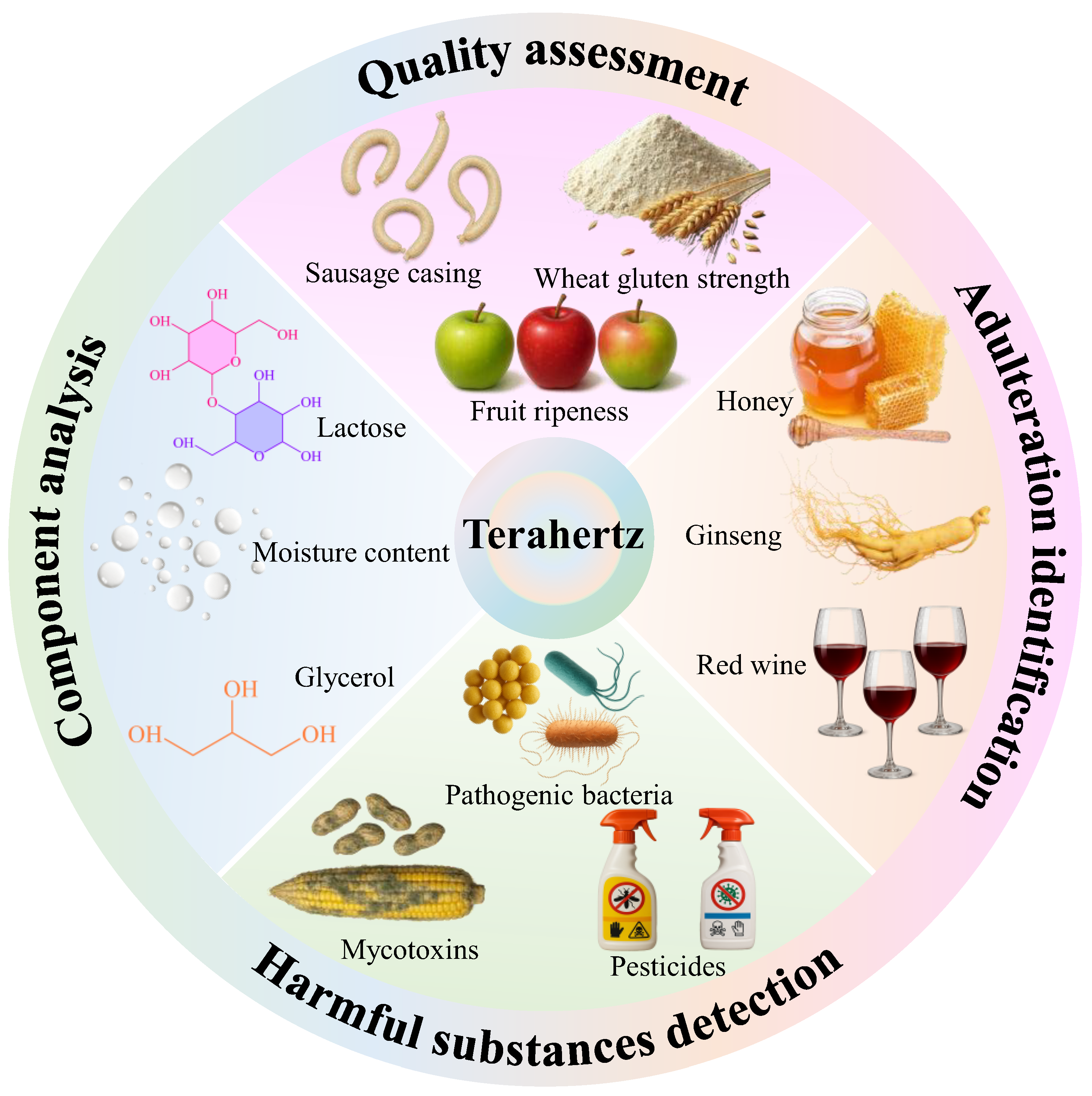

Disclaimer/Publisher’s Note: The statements, opinions and data contained in all publications are solely those of the individual author(s) and contributor(s) and not of MDPI and/or the editor(s). MDPI and/or the editor(s) disclaim responsibility for any injury to people or property resulting from any ideas, methods, instructions or products referred to in the content. |
© 2025 by the authors. Licensee MDPI, Basel, Switzerland. This article is an open access article distributed under the terms and conditions of the Creative Commons Attribution (CC BY) license (https://creativecommons.org/licenses/by/4.0/).
Share and Cite
Yu, P.; Shen, C.; Zhu, W.; Zhang, W.; Cheng, J.; Song, J. Recent Developments and Applications of Terahertz Spectroscopy in Food Analysis. Biosensors 2025, 15, 677. https://doi.org/10.3390/bios15100677
Yu P, Shen C, Zhu W, Zhang W, Cheng J, Song J. Recent Developments and Applications of Terahertz Spectroscopy in Food Analysis. Biosensors. 2025; 15(10):677. https://doi.org/10.3390/bios15100677
Chicago/Turabian StyleYu, Pengpeng, Chaoping Shen, Wenhui Zhu, Wenya Zhang, Junhui Cheng, and Jinxiu Song. 2025. "Recent Developments and Applications of Terahertz Spectroscopy in Food Analysis" Biosensors 15, no. 10: 677. https://doi.org/10.3390/bios15100677
APA StyleYu, P., Shen, C., Zhu, W., Zhang, W., Cheng, J., & Song, J. (2025). Recent Developments and Applications of Terahertz Spectroscopy in Food Analysis. Biosensors, 15(10), 677. https://doi.org/10.3390/bios15100677




